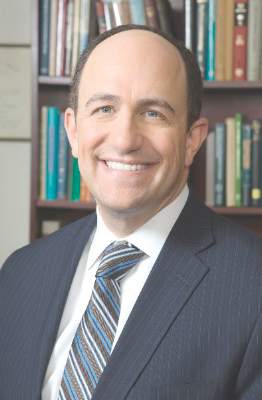User login
BOSTON – Inflammatory bowel disease (IBD) has gone from being a condition largely managed on a crisis basis to one in which the goal is to prevent acute exacerbations and preserve a low level of disease activity over its chronic course.
While this model saves costs and creates better patient outcomes overall, it requires specialists to approach care differently, including leveraging an ever-widening array of clinical innovations.
“The chronic disease management model requires regular monitoring and advanced technologies to better characterize the disease activity and response to therapy,” said Dr. David Rubin, section chief of gastroenterology, hepatology, and nutrition at the University of Chicago. In addition to keeping chronic disease from drifting away from stability, Dr. Rubin said, “Effective monitoring should allow proactive management decisions and ongoing control and changing disease natural history.”
The challenge has been to identify tools useful in monitoring patients with IBD to ensure that disease is under control, according to a panel of speakers addressing this topic at the 2016 AGA Tech Summit, which is sponsored by the AGA Center for GI Innovation and Technology. The relationship of inflammation in the bowel to symptoms is notoriously poor, including both a high degree of disease activity in those with relatively few symptoms and a low degree of inflammation in those seeking care because of a poor quality of life.
“We need better and less invasive ways to monitor disease control as well as better predictors of risk of exacerbations,” Dr. Rubin said. Although a variety of biomarkers are already used to evaluate IBD, such as C-reactive protein and fecal calprotectin levels, none is fully reliable as an isolated measure, according to Dr. Rubin. Ongoing studies are pursuing biomarkers measured in the urine, from the breath, and by genetic analysis, but the key to each is demonstrating that changing management on the basis of the information they provide results in better long-term outcomes.
Currently, endoscopy is the most reliable tool for evaluating disease activity and guiding therapeutic decisions, according to Dr. Edward V. Loftus, professor of medicine at the Mayo Clinic, Rochester, Minn., and a session copanelist with Dr. Rubin. Although several scoring systems are employed to reduce subjectivity in endoscopic evaluation of disease activity, Dr. Loftus suggested that no scoring system eliminates interobserver variability.
At least for clinical trials, employing central reading of endoscopic studies has been one approach to reduce interobserver variability and to “drive down placebo rates” that are typically substantial in drug trial studies. Not least important among endoscopic measures is the confirmation of mucosal healing.
“Mucosal healing is a binary concept. It is either complete or it is not,” explained Dr. Loftus, citing several studies suggesting that the risk of disease relapse is lower when mucosal healing is achieved. Endoscopy is currently the only reliable method of establishing mucosal healing. However, he said that precise measurement of disease activity “takes a little bit of training,” a problem that represents “an unmet need” for more efficient disease evaluation.
“One could envision somebody designing software built into the scope that will automatically score the degree of IBD severity.” Dr. Loftus said. “These tools have already resulted in a change in the types of clinical trial endpoints used, and one could argue that they are more objective now.”
The need for better tools for prognosis will only increase as treatments for IBD continue to expand, according to Dr. Gary R. Lichtenstein, professor of medicine at the University of Pennsylvania, Philadelphia. He emphasized that there is wide variability in response even to the most effective treatments. Tools useful for quickly evaluating when a therapy is or is not working would be extremely useful for switching patients to an alternative drug.
These alternative drugs include an expanding array of mechanisms of action with more reaching late stages of clinical testing, according to Dr. Lichtenstein, who reviewed the mechanism of integrin inhibitors, small-molecule therapies targeting the JAK pathway, and cytokine inhibitors. There are also strategies being pursued that involve manipulating the microbiome to control IBD.
“The therapies we have currently are totally inadequate,” said Dr. Lichtenstein, underscoring the excitement about clinical activity observed with drugs that offer novel mechanisms of action.
The activity in this field is being closely monitored by the AGA’s Center for Diagnostics and Therapeutics (CDT), which is chaired by Dr. Colin. W. Howden, gastroenterology chief at the University of Tennessee Health Science Center, Memphis. Although the interests of the CDT, which met last summer with the U.S. Food and Drug Administration to discuss issues of mutual interest in GI therapeutics, is not limited to IBD, this set of diseases was a focus in its first stand-alone conference held in October 2015. According to Dr. Howden, the discussion at that meeting provided the framework for the program at the 2016 AGA Tech Summit.
On Twitter @whitneymcknight
BOSTON – Inflammatory bowel disease (IBD) has gone from being a condition largely managed on a crisis basis to one in which the goal is to prevent acute exacerbations and preserve a low level of disease activity over its chronic course.
While this model saves costs and creates better patient outcomes overall, it requires specialists to approach care differently, including leveraging an ever-widening array of clinical innovations.
“The chronic disease management model requires regular monitoring and advanced technologies to better characterize the disease activity and response to therapy,” said Dr. David Rubin, section chief of gastroenterology, hepatology, and nutrition at the University of Chicago. In addition to keeping chronic disease from drifting away from stability, Dr. Rubin said, “Effective monitoring should allow proactive management decisions and ongoing control and changing disease natural history.”
The challenge has been to identify tools useful in monitoring patients with IBD to ensure that disease is under control, according to a panel of speakers addressing this topic at the 2016 AGA Tech Summit, which is sponsored by the AGA Center for GI Innovation and Technology. The relationship of inflammation in the bowel to symptoms is notoriously poor, including both a high degree of disease activity in those with relatively few symptoms and a low degree of inflammation in those seeking care because of a poor quality of life.
“We need better and less invasive ways to monitor disease control as well as better predictors of risk of exacerbations,” Dr. Rubin said. Although a variety of biomarkers are already used to evaluate IBD, such as C-reactive protein and fecal calprotectin levels, none is fully reliable as an isolated measure, according to Dr. Rubin. Ongoing studies are pursuing biomarkers measured in the urine, from the breath, and by genetic analysis, but the key to each is demonstrating that changing management on the basis of the information they provide results in better long-term outcomes.
Currently, endoscopy is the most reliable tool for evaluating disease activity and guiding therapeutic decisions, according to Dr. Edward V. Loftus, professor of medicine at the Mayo Clinic, Rochester, Minn., and a session copanelist with Dr. Rubin. Although several scoring systems are employed to reduce subjectivity in endoscopic evaluation of disease activity, Dr. Loftus suggested that no scoring system eliminates interobserver variability.
At least for clinical trials, employing central reading of endoscopic studies has been one approach to reduce interobserver variability and to “drive down placebo rates” that are typically substantial in drug trial studies. Not least important among endoscopic measures is the confirmation of mucosal healing.
“Mucosal healing is a binary concept. It is either complete or it is not,” explained Dr. Loftus, citing several studies suggesting that the risk of disease relapse is lower when mucosal healing is achieved. Endoscopy is currently the only reliable method of establishing mucosal healing. However, he said that precise measurement of disease activity “takes a little bit of training,” a problem that represents “an unmet need” for more efficient disease evaluation.
“One could envision somebody designing software built into the scope that will automatically score the degree of IBD severity.” Dr. Loftus said. “These tools have already resulted in a change in the types of clinical trial endpoints used, and one could argue that they are more objective now.”
The need for better tools for prognosis will only increase as treatments for IBD continue to expand, according to Dr. Gary R. Lichtenstein, professor of medicine at the University of Pennsylvania, Philadelphia. He emphasized that there is wide variability in response even to the most effective treatments. Tools useful for quickly evaluating when a therapy is or is not working would be extremely useful for switching patients to an alternative drug.
These alternative drugs include an expanding array of mechanisms of action with more reaching late stages of clinical testing, according to Dr. Lichtenstein, who reviewed the mechanism of integrin inhibitors, small-molecule therapies targeting the JAK pathway, and cytokine inhibitors. There are also strategies being pursued that involve manipulating the microbiome to control IBD.
“The therapies we have currently are totally inadequate,” said Dr. Lichtenstein, underscoring the excitement about clinical activity observed with drugs that offer novel mechanisms of action.
The activity in this field is being closely monitored by the AGA’s Center for Diagnostics and Therapeutics (CDT), which is chaired by Dr. Colin. W. Howden, gastroenterology chief at the University of Tennessee Health Science Center, Memphis. Although the interests of the CDT, which met last summer with the U.S. Food and Drug Administration to discuss issues of mutual interest in GI therapeutics, is not limited to IBD, this set of diseases was a focus in its first stand-alone conference held in October 2015. According to Dr. Howden, the discussion at that meeting provided the framework for the program at the 2016 AGA Tech Summit.
On Twitter @whitneymcknight
BOSTON – Inflammatory bowel disease (IBD) has gone from being a condition largely managed on a crisis basis to one in which the goal is to prevent acute exacerbations and preserve a low level of disease activity over its chronic course.
While this model saves costs and creates better patient outcomes overall, it requires specialists to approach care differently, including leveraging an ever-widening array of clinical innovations.
“The chronic disease management model requires regular monitoring and advanced technologies to better characterize the disease activity and response to therapy,” said Dr. David Rubin, section chief of gastroenterology, hepatology, and nutrition at the University of Chicago. In addition to keeping chronic disease from drifting away from stability, Dr. Rubin said, “Effective monitoring should allow proactive management decisions and ongoing control and changing disease natural history.”
The challenge has been to identify tools useful in monitoring patients with IBD to ensure that disease is under control, according to a panel of speakers addressing this topic at the 2016 AGA Tech Summit, which is sponsored by the AGA Center for GI Innovation and Technology. The relationship of inflammation in the bowel to symptoms is notoriously poor, including both a high degree of disease activity in those with relatively few symptoms and a low degree of inflammation in those seeking care because of a poor quality of life.
“We need better and less invasive ways to monitor disease control as well as better predictors of risk of exacerbations,” Dr. Rubin said. Although a variety of biomarkers are already used to evaluate IBD, such as C-reactive protein and fecal calprotectin levels, none is fully reliable as an isolated measure, according to Dr. Rubin. Ongoing studies are pursuing biomarkers measured in the urine, from the breath, and by genetic analysis, but the key to each is demonstrating that changing management on the basis of the information they provide results in better long-term outcomes.
Currently, endoscopy is the most reliable tool for evaluating disease activity and guiding therapeutic decisions, according to Dr. Edward V. Loftus, professor of medicine at the Mayo Clinic, Rochester, Minn., and a session copanelist with Dr. Rubin. Although several scoring systems are employed to reduce subjectivity in endoscopic evaluation of disease activity, Dr. Loftus suggested that no scoring system eliminates interobserver variability.
At least for clinical trials, employing central reading of endoscopic studies has been one approach to reduce interobserver variability and to “drive down placebo rates” that are typically substantial in drug trial studies. Not least important among endoscopic measures is the confirmation of mucosal healing.
“Mucosal healing is a binary concept. It is either complete or it is not,” explained Dr. Loftus, citing several studies suggesting that the risk of disease relapse is lower when mucosal healing is achieved. Endoscopy is currently the only reliable method of establishing mucosal healing. However, he said that precise measurement of disease activity “takes a little bit of training,” a problem that represents “an unmet need” for more efficient disease evaluation.
“One could envision somebody designing software built into the scope that will automatically score the degree of IBD severity.” Dr. Loftus said. “These tools have already resulted in a change in the types of clinical trial endpoints used, and one could argue that they are more objective now.”
The need for better tools for prognosis will only increase as treatments for IBD continue to expand, according to Dr. Gary R. Lichtenstein, professor of medicine at the University of Pennsylvania, Philadelphia. He emphasized that there is wide variability in response even to the most effective treatments. Tools useful for quickly evaluating when a therapy is or is not working would be extremely useful for switching patients to an alternative drug.
These alternative drugs include an expanding array of mechanisms of action with more reaching late stages of clinical testing, according to Dr. Lichtenstein, who reviewed the mechanism of integrin inhibitors, small-molecule therapies targeting the JAK pathway, and cytokine inhibitors. There are also strategies being pursued that involve manipulating the microbiome to control IBD.
“The therapies we have currently are totally inadequate,” said Dr. Lichtenstein, underscoring the excitement about clinical activity observed with drugs that offer novel mechanisms of action.
The activity in this field is being closely monitored by the AGA’s Center for Diagnostics and Therapeutics (CDT), which is chaired by Dr. Colin. W. Howden, gastroenterology chief at the University of Tennessee Health Science Center, Memphis. Although the interests of the CDT, which met last summer with the U.S. Food and Drug Administration to discuss issues of mutual interest in GI therapeutics, is not limited to IBD, this set of diseases was a focus in its first stand-alone conference held in October 2015. According to Dr. Howden, the discussion at that meeting provided the framework for the program at the 2016 AGA Tech Summit.
On Twitter @whitneymcknight
AT THE 2016 AGA TECH SUMMIT



